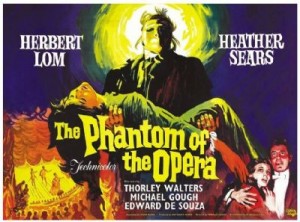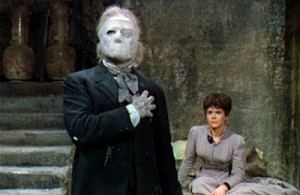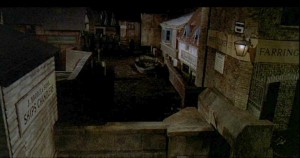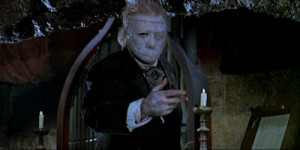The Phantom of the Opera **** (1962, Herbert Lom, Heather Sears, Edward de Souza, Michael Gough) – Classic Movie Review 389
‘BENEATH HIS MASK… the Grotesque Face of Horror Unimaginable! INSIDE HIS HEART… the Desperate Desire for Beauty and Love!’
Director Terence Fisher’s 1962 British remake of the 1910 Gaston Leroux novel Le Fantôme de l’Opéra is welcome and enjoyable. Hammer Films’ gothic romantic horror movie The Phantom of the Opera proves a sterling piece of work.
Following the famed footsteps of Lon Chaney Sr in The Phantom of the Opera (1925) and Claude Rains in Phantom of the Opera (1943), Herbert Lom proves ideally cast, and gives an extremely intelligent, sensitive and sympathetic performance as The Phantom, romancing the understandably reluctant young singer Christine Charles (Heather Sears) at the London Opera House. Well, for a start, he’s wearing a mask, isn’t he? And he’s abducted her, hasn’t he?, with the aid of his dwarf helper (Ian Wilson)!
Director Terence Fisher takes advantage of a budget that is considerably more lavish than usual for Hammer Film to turn in a strikingly handsome-looking film (in a weirdly unreal Eastmancolor/Technicolor). And, along with the brilliant production, he ensures that there is an intensely emotional atmosphere, staying faithful to the spirit of the Gaston Leroux source work. It might have had a more lavish budget than usual but the key prop of The Phantom’s mask was cheaply and quickly made just before shooting out of cloth, tape, string and paint.
The usual Hammer horror audience was disappointed at the time by its low horror content, and performed unsuccessfully at the box office, for this is more of a Gothic romance, although horror isn’t neglected altogether and there is the odd eye stabbing to appeal to the horror fans, a very nasty moment for Patrick Troughton’s character The Rat Catcher.
Naturally, the UK cinema version was cut by the BBFC for an A certificate, editing the eye-stabbing and shots of a hanging body, as well as extensive edits to scenes showing the creation and final unmasking of the Phantom. As usual, later video and DVD releases are uncut.
Michael Gough enjoys himself in one of his usual typically overripe performances as Lord Ambrose D’Arcy, the greedy, imperious and lascivious impresario who makes the mistake of pinching the credit to the music belonging to The Phantom, then just the poor composer Professor L Petrie. As a starving composer, Petrie was forced to sell all his music, including the opera, to Ambrose for a tiny fee, thinking his work being published would bring him recognition.
After he discovers Ambrose is publishing the music under his own name, The Phantom bursts into the printers where his score is being printed with Ambrose’s name on it and accidentally sets off the fire that leaves him facially disfigured and having to wear the famous mask. Thinking it is water to try to put out the fire, he splashes acid on his face and hands. He jumps into the river and is swept into an underground drain, where he is rescued and cared for by the dwarf.
That’s the prologue, though it is seen in flashback in tilted camera angles towards the end of the film, the only time Lom is seen without his mask until his final unmasking. The main story (and film) starts some five years after in Victorian London on a December night in 1900, when The Phantom has to return up to the London Opera House to sort things out when they are on the point of staging one of the scores stolen from him.
The first night of the new season at the London Opera House finds the opening of a new opera by Lord Ambrose, who gets angry when the opera manager Lattimer (Thorley Walters) tells him no one will sit in one of the boxes because it is supposedly haunted. Pandemonium ensues when the body of a murdered stagehand swings out of the wings during first aria of the show’s star, Maria (Liane Aukin), and the show is postponed, with Maria refusing to perform again. The opera’s producer Harry Hunter (Edward de Souza) finds a promising new young star in chorus girl Christine Charles (Heather Sears), lusted after by Lord Ambrose.
The rampaging and terrorising that follow, admittedly may be on a mild scale, especially by today’s standards, but it is still highly entertaining, and there is a strong and effective horror-stricken climax to top it off.
The film’s producer Anthony Hinds wrote the very effective screenplay under his pen name as John Elder, tweaking the Leroux novel enough to provide a fresh experience while still keeping the essence and themes of the original. Hinds said in interviews: ‘I wrote the script for Cary Grant’, who had expressed an interest in doing a Hammer horror.
It was shot between 21 November 1961 – 26 January 1962 at Bray Studios, Down Place, Oakley Green, Berkshire, using exterior sets on the studio’s backlot previously used for many Hammer productions, and at New Wimbledon Theatre, The Broadway, Wimbledon, London, standing in magnificently for the film’s ‘London Opera House’. Hammer rented the theatre for three weeks, and more than 100 musicians and chorus people were hired.
The film had a reported budget of £200,000, but it was reported after principal shooting to be £400,000, unusually high for a Hammer film.
Patricia Clark provides the dubbed soprano voice for Heather Sears.
Hammer screened it in British cinemas in 1962 with Captain Clegg.
Lom recalled: ‘The Hammer people wanted me to smash my head against a stone pillar, because they said they couldn’t afford one made of rubber. I refused to beat my head against stone, of course. This caused a big crisis because it took them half a day to make a rubber pillar that looked like stone. And of course, it cost a few pennies more. Horror indeed!’
Also in the cast are Harold Goodwin as Bill, Marne Maitland as Xavier, Miriam Karlin as Charwoman, Patrick Troughton as The Rat Catcher, Renée Houston as Mrs. Tucker, Keith Pyott as Weaver, and Ivor Evans as opera singer.
It runs 84 , (Extended Version). For the film’s American TV premiere on NBC, additional footage of Scotland Yard police inspectors (played by Liam Redmond and John Maddison) looking for the Phantom was filmed at Universal Studios to increase the running time.
Lom died on September 27 2012, at the age of 95. Sears died on January 3 1994, at the age of 58.
© Derek Winnert 2013 Classic Movie Review 389
Check out more reviews on http://derekwinnert.com/








